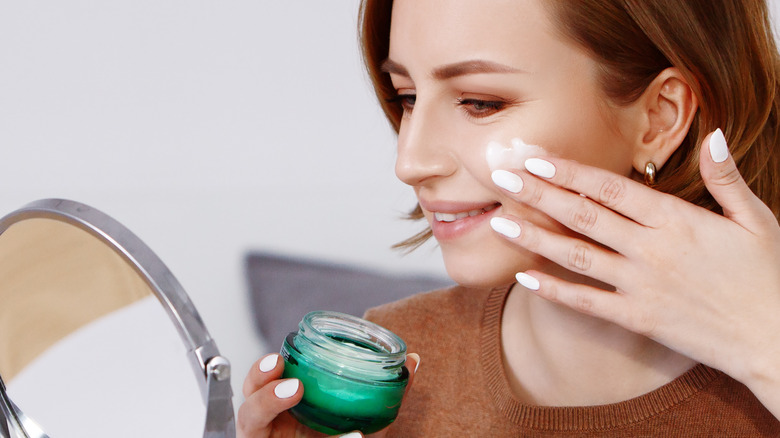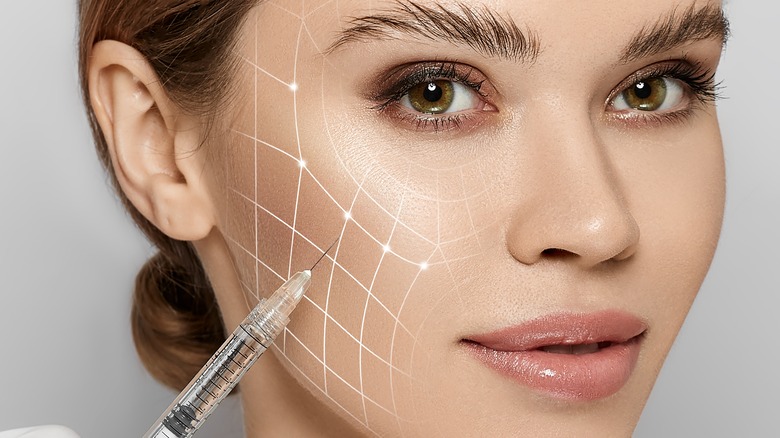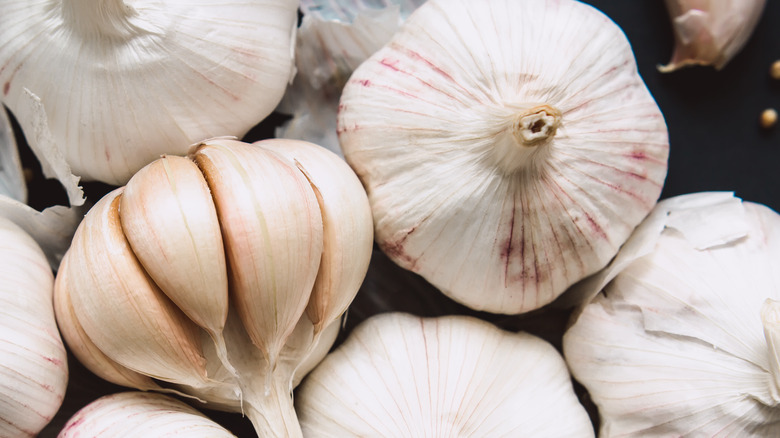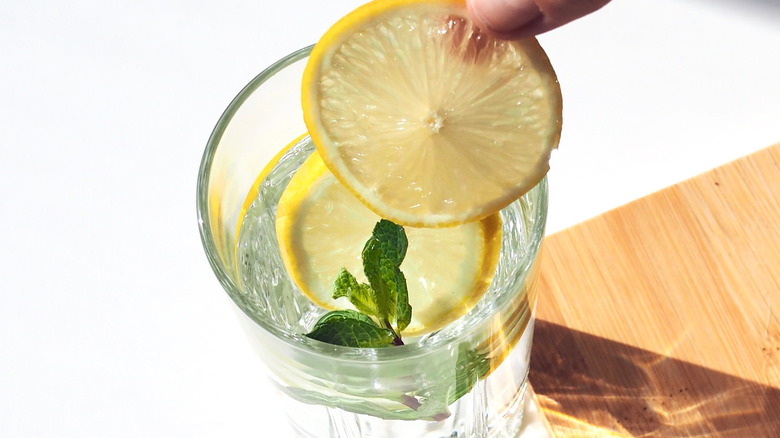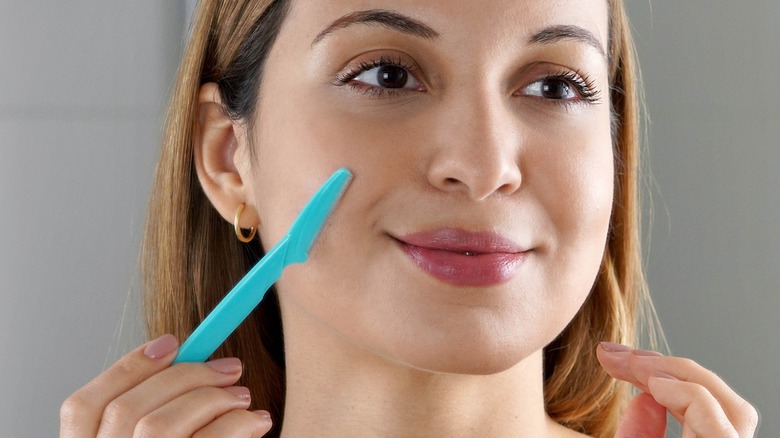At-Home Beauty Hacks You're Definitely Going To Want To Skip
We may receive a commission on purchases made from links.
Even with the vast availability of beauty products from well-established brands, most of us will always be on the hunt for the next best treatment for our looks. If you look to Instagram and TikTok as the barometers for the latest scoop on beauty tips, you'll find tons of clever ways of making DIY personal care products that promise spa-worthy results while using dirt-cheap household items. For instance, instead of going for a costly PRP treatment to stunt hair growth, you can remove unwanted hair by applying a mix of lemon juice and baking soda. Also, who needs to pay big bucks for exfoliating masks when you can invent homemade face scrubs using kitchen ingredients like olive oil and honey? Actually, there are many beauty hacks that earn a stamp of approval from dermatologists. For instance, mixing turmeric powder with milk can give you an effective formula for facial hair removal, dermatologist Dr. Annie Gonzalez tells Byrdie, because, as she says, "Turmeric is known to lighten the skin and slow hair growth."
That said, even though some ingredients in skincare products are similar to those you can find in your kitchen, mixing up various ingredients together when you don't have a good grounding in cosmetology can do a number on your skin, aesthetician Haley Kulow warns (via Dermstore). For example, some homemade concoctions can give your skin more breakouts and cause discoloration. Therefore, check out these at-home beauty techniques that dermatologists strongly advise against before joining the DIY beauty craze.
1. Inject yourself with facial fillers
Getting fillers is the fastest way to reduce the appearance of deep creases and skin volume loss caused by aging and certain medical conditions, per FDA. Dermal fillers can smooth fine lines and refill loss of volume, giving your sagging skin a fuller and more youthful look. However, the FDA also notes that you should get fillers injected under your skin by a healthcare provider who is knowledgeable about cosmetology and experienced in managing complications. Injecting filler should not be viewed as a cosmetic technique but rather as a medical procedure.
Despite this warning, some people have attempted to inject themselves with hyaluronic acid, a material found in fillers that makes the skin look plumper and more hydrated. This is likely because of the rise in online guides for self-injecting fillers. If you're a layperson who doesn't know much about facial anatomy or the way needles should go, you're risking a botched filler and irreversible facial paralysis. Some dangers linked to the self-injection of hyaluronic acid include allergic reactions, infection, and skin tissue death, among other things, per Face Forward Medical Aesthetics. If you want to plump your lips and lift your cheeks, check out healthcare professionals who are trained in administering dermal fillers for professional advice and treatment.
2. Rub garlic on the face to get rid of acne
If you have researched ways to get rid of acne, you might have come across this hack that involves using raw garlic. Yup! Rubbing garlic on the face was one of the biggest skincare trends of 2016. This fad took off after beauty vlogger Farah Dhukai took to her Instagram to share how she flattened out her acne overnight by rubbing garlic on her pimples and leaving it on throughout the night. It's hard to say how many kernels of truth there are in this hack, but going natural isn't always the best route for skincare.
Raw garlic contains allicin, a chemical compound with antimicrobial properties that could potentially decrease the size of the pimples. Nonetheless, when applied directly to the skin, allicin can give you rashes and blisters. In an even darker turn, applying garlic to the skin can cause a burn, as is a case published in the Indian Dermatology Online Journal. In this incident, a 60-year-old lady applied 10 to 12 cloves of finely ground garlic to her right knee joint and covered it with a cotton cloth overnight. The next morning, she woke up to a burning ulcerative lesion on her knee. After being rushed to the hospital, she was diagnosed with a "garlic burn." Garlic might have tons of benefits, but it's better to treat your acne using products prescribed by your dermatologist instead of blindly following Internet hacks.
3. Use lemon juice on your face
Beginning your day with a glass of lemonade has numerous positive effects on your skin, including boosting the amount of collagen in your skin and combating toxins that cause breakouts. However, you should never apply super-acidic drops of a freshly squeezed lemon onto your skin. Lemon juice may be a component of your vitamin C serum or peel, but it's added to the mixture in a safe quantity, according to Dr. Susan Bard (via Greatist). Aside from being a powerful antioxidant, vitamin C, the active ingredient in lemon, is also an acid that burns the skin. So if you apply acidic lemon juice directly to your skin and stand in the sun, you'll end up with a burn and possibly scarring.
As cosmetic chemist Michelle explains on her blog Lab Muffin Beauty Science, DIY lemon juice skincare has been connected to chemical leukoderma, a condition where patches of the skin grow unevenly lighter, leaving the skin dotted with spots. Putting lemon juice on your face and using vitamin C serum are very different things. Fresh lemons are too harsh for the skin and are able to plague your skin with breakouts and depigmentation, while vitamin C serums are formulated with a safe concentration of active ingredients and are a better choice for your skincare routine.
4. The DIY dimple hack
In both the East and the West, cheek dimples are considered physically attractive. It's widely agreed that people with dimples have the most adorable smiles; think Ariana Grande and Miranda Kerr. While dimples are an inherited trait, you can still have them surgically embedded. Given the fascination that a significant amount of the world population has with dimples, TikTok user @arwaakhu showed everyone a hack to get a sinkhole on the cheek easily. In her video, she uses her fingers and pencils to push into the cheeks, and the result she gets is an indentation on her cheek that looks like a dimple.
Weighing on this hack, dermatologist Dr. Melanie Palm tells Allure that there's no way to achieve facial dimples using a non-invasive or minimally invasive method. So technically, shoving the cheeks with pens and fingers can only "cause a temporary effect at best." Even if you come under the knife to get dimples, the results cannot compare with the natural ones.
5. Dermaplane and gua sha at home
Dermaplaning is a good way to rid your face of fine vellus hair and dead skin cells to reveal a clearer and smoother layer of skin using a sterile dermaplaning razor. However, dermaplaning might not be a procedure you want to conduct at home, especially if you have sensitive skin. If you have acne bumps, rosacea, eczema, polycystic ovary syndrome, or other conditions that might result in comedones, pustules, or inflammation, you are not geared for a dermaplaning treatment, per Healthline. Dermaplaning yourself when you have skin disorders will only exacerbate your condition or, worse, result in bloody cuts and permanent scars.
The same can be said for gua sha, a skin-scraping technique that boosts collagen production. According to dermatologist Dr. Elaine F. Kung (via Allure), her patient with rosacea ended up with a worsening condition and more visible blood vessels on her face after doing gua sha at home. She compared the procedure to the pilling and other texture changes that happen to overused clothing, saying, "The same thing can happen with our skin if you cause friction on it too frequently." At-home beauty treatments might save you money at first, but if they go wrong, you'll end up losing more money to save your beauty.
